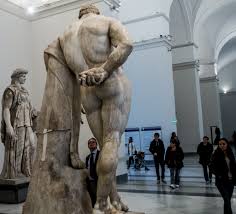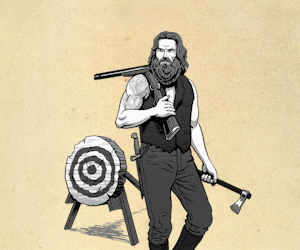More than four-fifths of American men suffer from a debilitating glutes disease that doctors aren’t talking about. It’s an insidious disease that causes low back pain, decreased strength, knee pain, weakened ankles and feet, and balance and coordination issues. So why aren’t more men aware that they have PAS?
PAS, also known as Pancake Ass Syndrome, isn’t talked about with men because men don’t view the gluteal muscles as an “essential” muscle group to build in the gym. Our modern sedentary lifestyles have drastically weakened and deflated these powerhouse muscles. Countless men spend years bench pressing and curling their hearts out. The one muscle that will improve quality of life more than shirt-splitting arms gets neglected.
Why your glutes are so important
 Well, besides looking better naked or in a pair of jeans, your glutes are a transfer point for power within your body. If you want to run faster or longer, you need strong glutes. If you want to squat more weight, you need strong glutes. And if you want to deliver a kick that would make Connor McGregor hit the mat, you need glutes that salute.
Well, besides looking better naked or in a pair of jeans, your glutes are a transfer point for power within your body. If you want to run faster or longer, you need strong glutes. If you want to squat more weight, you need strong glutes. And if you want to deliver a kick that would make Connor McGregor hit the mat, you need glutes that salute.
Your gluteal muscle group does a lot. They extend your hip, abduct of your legs, and externally and internally rotate the hip joint. They also support the extension of your knee. Athletes like sprinters or football players need quick bursts of speed to win. If they suffer from PAS, they won’t be able to exert the tremendous amount of force they need to win.
You’re likely not Usain Bolt or Le’veon Bell, and maybe you think you don’t need explosive hip extending power. But if you want to gain strength in the gym, or be able to get up out of a chair when you’re 80, you need to focus on exercises that require powerful and explosive hip extension.
It’s All in the Hips
Hip extension happens when you move your leg behind your hips. Flexion happens when you bring your leg closer to your hips. Everyday movements like standing up from a chair, walking, running, jumping, and climbing stairs takes your hips through both flexion and extension.
It’s the extension of your hips that engages your glutes. So when you drop it like it’s hot into the bottom of a squat, you’re flexing your legs into your hips. When you rise from the bottom, then you’re extending your hips and engaging your glutes. To build stronger and better functioning glutes, you actually need to take your hips through flexion and extension. And the first thing you need to master is the art of the hip hinge.
Cable Pull-Through
The day I felt my glutes wake up doing this exercise might have been the greatest day in my life. And when it comes to helping my online clients improve their hip hinge pattern, there’s no better exercise for than the cable pull-through.
Side note: improving your hip hinge pattern can be done during rest periods of your big lifts like squats, deadlifts, or bench. Use this drill to groove the hip hinge pattern so that you can hinge like a boss.
Basically, push your hips back like your butthole is playing a game of Hungry Hungry Hippos and is trying to eat the weights behind you. Even if you have a drastic case of PAS, you’ll feel your glutes fire with this exercise.
Cable Pull-Throughs can be used as a warm-up before a lower body or glute focused workout. Or you can add them to the end of a workout to really toast your glutes.
Hip Thrusts
Now that you’ve woken those glorious glutes up with cable pull-throughs, you can embark on hitting those bad boys with best booty building exercise known to man. Bret Contreras, The Glute Guy, is the inventor of this masterpiece of exercise science. And if you follow The Rock or James Harrison on Instagram, you’ve likely seen them thrusting their hearts out.
Like pull-throughs, the hip thrust takes your hips through flexion and extension. And because of its versatility, you can do hip thrusts with a barbell, dumbbell, bands, or bodyweight.
Your glutes can handle a ton of volume. So you don’t need to really worry about overtraining them. I mean, I wouldn’t train them every day of the week with no rest, but you can hit them with weights one day and then do something like bodyweight the following day without harming recovery.
If you want to really wake your ass up and build glutes that salute, you need to include some single leg hip thrusts into your training.
Curtsy Lunge
Outside of the fun of flexing and extending your hips, your glutes also function to abduct your leg. Abduction just means that you’re moving away from the midline of the body. You can combine abduction with flexion and extension when you do lunges.
Now, if you happen to have shoddy knees, and I’ll tell you more later about how to improve your knee health, lunges can hurt. A lot. Reverse lunges, however, are great for those with crappy knees because it places more emphasis on your glutes and hamstrings.
But, if you don’t happen to have dilapidated knees, and you want to really engage your glutes, look no further than the curtsy lunge. The curtsy lunge is one of my favorite bodyweight exercises to program for clients. It works well as the second exercise in a superset with dumbbell Romanian deadlifts or single leg deadlifts. Or do them as a separate exercise all on their own. Make sure to focus on squeezing your glutes the entire time and feeling your booty push you up from the bottom.
Step Downs
When someone says “core training” you probably think of abs, right? You’re not wrong, here, but then you kind of are. The truth is, your core is more than your abdominals. In fact, your core is really comprised of your abs, erector spinae, obliques, and yes, your glutes.
Think of your core like an anchor. Your spine is the shank. The crown is your pelvic floor. And the arms on each side of the crown are your hips. With that reference in mind, your glutes act as stabilizers for the arms to the crown.
Remember when I said that your glutes internally and externally rotate your hips? Well, they do that. But they also work to stabilize your hips as you move through your day. Stronger glutes help your hips function better. And that makes walking, running, jumping, and all the other things you do with your hips more effective and efficient.
When it comes to increasing hip stability and strength, look no further. There’s a trick to these, though. Before you start the motion, you have to raise your opposite hip up. This helps isolate and put more stress on the glute of your dangling foot.
To really hit your glutes, make sure you’re hinging your hips as you lower your leg down; trust me, you won’t need much distance at first. So start with a small step and not a high block like I’m demonstrating.
To perform this exercise, let one foot hang off the edge of a raised platform. Raise your opposite side hip — this is your starting position. While hinging at the hips, let your foot lower toward the ground, but angled slightly behind you. Push through your feet — feeling your glutes engage — and come back to standing. If you need assistance when attempting these, start these near a rack at your gym or use a dowel rod to give you some support. Don’t rely on the support, but have it there to start at least.
Perform 3 sets of 5-8 reps per side at the end of your workout. As you get better with the exercise, increase the depth at which you step down.
Back Pain and Your Glutes
According to the National Institutes of Health, 80 percent of adults experience low back pain at some point in their lifetimes. The NIH also states that the majority of low back pain is largely due to mechanical issues. Some of these issues can occur from severe injury like car accidents, disc degeneration, herniated discs, or sciatica. But the number one mechanical cause of low back pain is from strains and sprains.
Our industrialized society sits for hours on end. Hell, I’ve been sitting for nearly an hour while I write this article. Sitting tightens your hip flexors. And since you sit on your glutes, well, you’re weakening them because you don’t use them. Here’s why this matters. Tight hip flexors pull on your hips, flexing them toward your legs, and cause your pelvis to go into what is known as anterior pelvic tilt. This also lengthens and weakens your hamstrings, and places your lower back into extension. So combine that with weak and deadened glutes, and guess what? Since your hamstrings can’t compensate for your weakened glutes, your lower back takes over.
Because of this, you’ll also lose the stability and function of your abdominal muscles, aka, you weaken your core. All of that comes together and creates a dangerous cocktail for back pain. So those with Pancake Ass Syndrome are at a higher chance of developing back pain. This is why it’s so important to train the non-mirror muscles — hamstrings, glutes, lats, rear delts. All of those muscles work in tandem to keep you walking, lifting, and living at your best.
Maximus Medius Minimus: The Roman God of Ass
But if you want to develop strong and supple glutes that will rid you of PAS forever, you need to also train the other two muscles of your glutes — the gluteus medius and minimus.
Your medius and minimus work in abduction, moving your leg away from your body. But they also assist in internal rotation and external rotation of your hip joint. Have you ever experienced or seen knee valgus? Knee valgus is the fancy science word for, “knees caving in toward the midline of the body.” So if you squat and your knees move toward one another, your medius and minimus are weak. You may even see this in your gait as you run as well. And that my friend, is a sign your running career won’t last long.
Knee joint imbalances can occur from overtraining your quads and under-training your hamstrings. But they can also occur when you have weak and poor functioning glutes, specifically, your medius and minimus.
The medius and minimus function to flex and internally rotate the hip on the anterior portion, extends and externally rotates the hip on the posterior portion, and
they’re principally called into action when supporting your body on one limb.
Exercises that isolate and focus on both the medius and minimus aren’t complicated. But they will seem boring at first. Trust me, though, you’re gonna feel it the next day.
Here are a few of my favorites
X-Band Walks
Mini Band 4-Way Walks
Lateral Lunges
Clamshells
Cable Abduction
Pro Tip
Picking up a pair of Mini Bands will cost you about $20. But if you travel a ton, they’re easily stowed in your luggage or in your gym bag. They will completely change the game for you when it comes to glute training.
Defeating Pancake Ass Syndrome is not an easy task. It will take hard work and require some heavy lifting. But abolishing PAS will help you and millions of other men increase total body strength and keep their bodies operating at their highest level possible for years to come.











